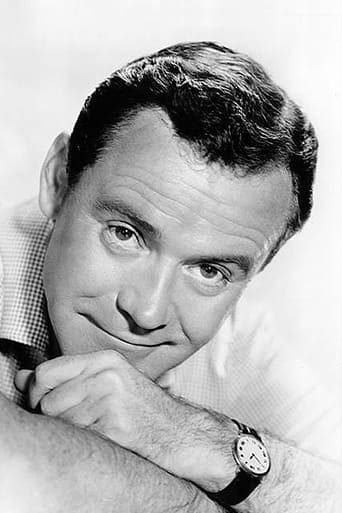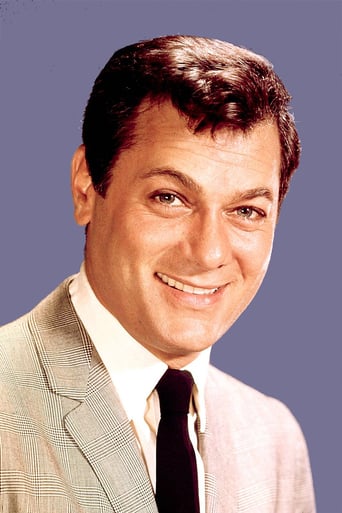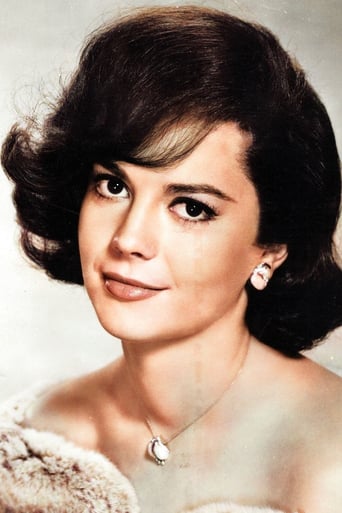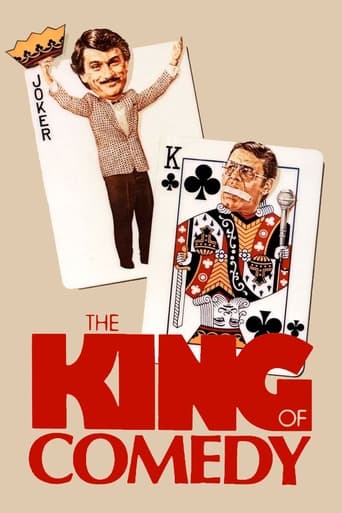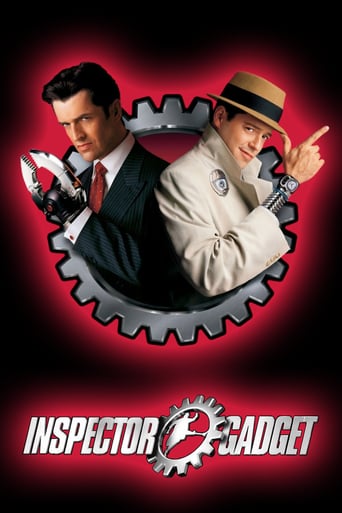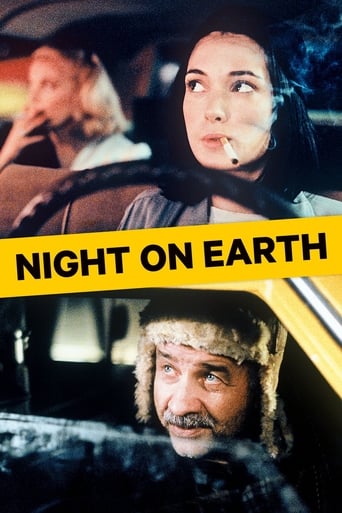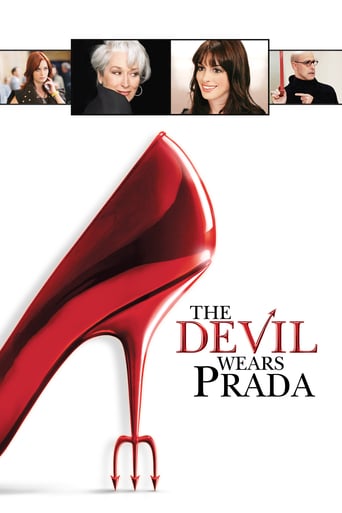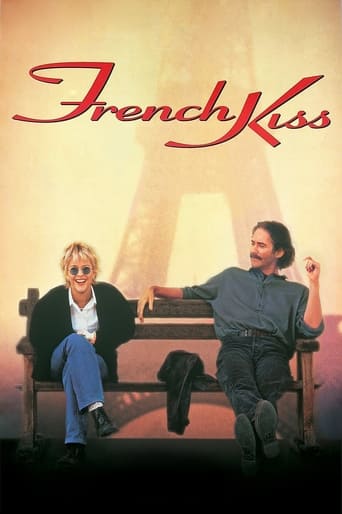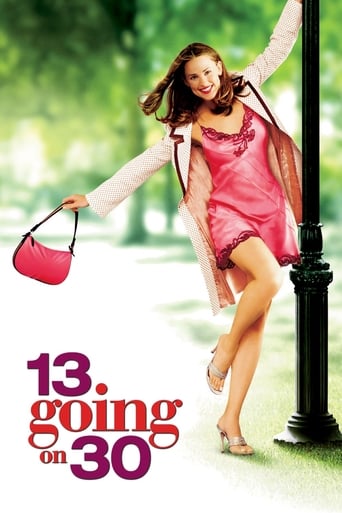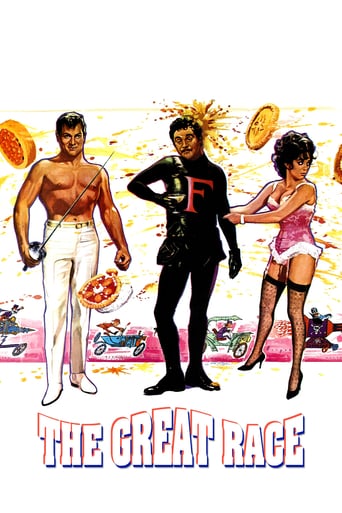

The Great Race (1965)
Professional daredevil and white-suited hero, The Great Leslie, convinces turn-of-the-century auto makers that a race from New York to Paris (westward across America, the Bering Straight and Russia) will help to promote automobile sales. Leslie's arch-rival, the mustached and black-attired Professor Fate vows to beat Leslie to the finish line in a car of Fate's own invention.
Watch Trailer
Cast
Similar titles
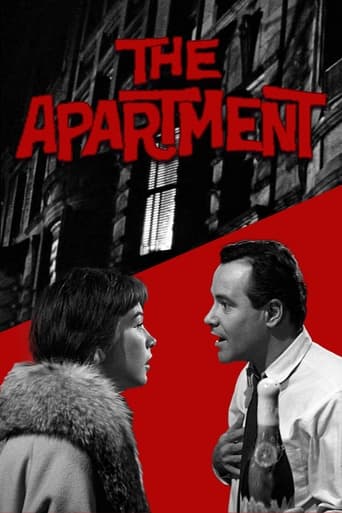
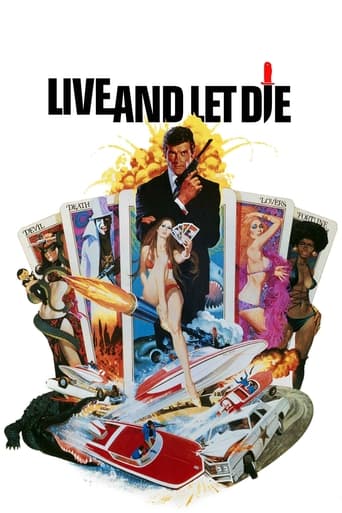
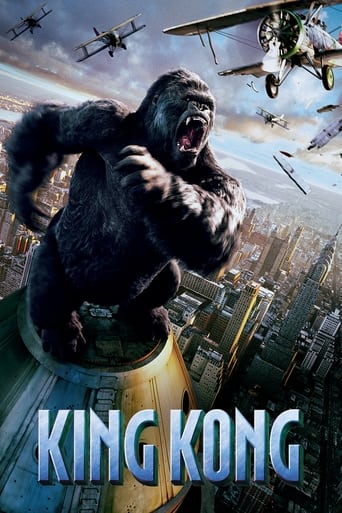

Reviews
A Masterpiece!
Yo, there's no way for me to review this film without saying, take your *insert ethnicity + "ass" here* to see this film,like now. You have to see it in order to know what you're really messing with.
Although I seem to have had higher expectations than I thought, the movie is super entertaining.
A terrific literary drama and character piece that shows how the process of creating art can be seen differently by those doing it and those looking at it from the outside.
This Blake Edwards-Arthur Ross gem opens like a cartoon serial - with Tony Curtis as a white clad adventurer dubbed The Great Leslie in a Road Runner-like role and all-in-black Jack Lemmon - assisted by Peter Falk as Max - is the jealous Professor Fate playing the Wile E. Coyote - and ends with a Prisoner of Zenda send-up - with Lemmon in the title/dual role and Curtis as the hero that battles Ross Martin (and George Macready) to save his mechanic (Keenan Wynn) and the emancipated suffragette reporter that Natalie Wood plays.In between is a delightfully entertaining story wrapped around a fictional early twentieth century automobile rally from New York to Paris that features elaborate set pieces, including an iceberg used to cross the Pacific (one wonders what the plan would have been if not for this accident), and incorporates countless sight gags - like a grand pie fight - from the kind of comedies that Laurel and Hardy (to whom the film is dedicated) made.This comedy won an Academy Award for its special sound effects, was nominated for Russell Harlan's lavish color cinematography, editing by Ralph Winters, sound, and its original song "The Sweetheart Tree" performed by Wood (dubbed by Jackie Ward), though Dorothy Provine's "He Shouldn't A Hadn't A Oughtn't A Swang on Me" is much more memorable.Arthur O'Connell plays Wood's reluctant publisher while Vivian Vance plays his pre-Nineteenth Amendment activist wife; Marvin Kaplan plays O'Connell's hapless assistant. Larry Storch and Denver Pyle are among those who appear in the obligatory Wild West (complete with barroom brawl) sequence.
As I've rewatched this movie a few times I have come to appreciate it even more. Epic, yet episodic, and much more entertaining than the similar yet staid "Around the World in 80 Days". The extras budget alone on this must have been enormous! Granted, there isn't a lot of actual "racing" shown but the encounters along the way are memorable. The longer version is an event for an evening, one that includes the Overture, Entr'acte, and Exit Music. Also best seen in hi-definition.The humor can be variously described as madcap, slapstick, cartoony, but rarely subtle. Still, even if there are only a few belly-laugh moments, this picture is loaded with elements that can make one chuckle throughout.The photography and location work is beautiful, the actors perfect for their roles (although Natalie Wood hams up the "cartoony" factor by quite a bit - nevertheless, she is quite lovely to look at.) Jack Lemmon as Professor Fate is one of the all-time best screen villains ever.The longer version is an event for an evening, one that includes the Overture, Entr'acte, and Exit Music. Also best seen in hi-definition. Funny, I never once thought of Lemmon and Curtis having also been together in that other famous comedy until someone mentioned it to me. I like this one so much more.
Other reviews have good information about the plot and acting in "The Great Race." So, my comments will cover some things that I didn't see in reviews. Blake Edwards used a lot of past events in this movie – from Hollywood and elsewhere, to lampoon those events and some topics of the times. He used the real Great Race of 1908 as his overall comedy "vehicle" (a pun by coincidence?). The real event probably had very little comedy for the participants. Although when one reads the details of the finish, it seems obvious that at least one entry tried some shenanigans. The race was a big deal in its time, and we have some interesting artifacts from that event, which I'll mention later. I'm sure some similarities with the movie will be obvious here, as well as some scenes that may have been inspired by the real race. The real race was sponsored by the New York Times and Le Matin of Paris. Six cars were entered in the race from four countries. France had three entries and one car each came from the U.S., Italy and Germany. The race was to cover 22,000 miles. The best of roads at the time were poor by today's standards, and most places had no roads at all. Wherever possible, the cars straddled and followed railroad tracks. Where there were no tacks, the cars drove cross country. The original plan was to drive the entire distance by crossing the frozen Bering Strait between Alaska and Russia. But it was changed to ferry the cars from Seattle to Valdez, AK. Then, when the leading car arrived there, the Alaskan conditions were so bad that it was impossible to proceed further by land. So, from Valdez, the race went by ship to Japan, then by ferry across the Sea of Japan to Vladivostok, Siberia.So, who won? The U.S. entry, the Thomas Flyer, driven by George Schuster, was the first to cross the U.S., and it entered Paris on July 30 – 169 days after starting. The German Protos had arrived in Paris four days earlier, but was penalized 30 days because it didn't go to Alaska. The Italian Züst was the only other car to finish the race. It arrived in Paris on September 17. None of the three French entries made it past Vladivostok. The cars had teams of three or four men, and some of the men were replaced along the route. George Schuster was the only American to go the entire route. When the Americans returned to the U.S., they had a heroes welcome and ticker-tape parade in New York City. Now for the artifacts. The winning Thomas Flyer and the race trophy are in the National Automobile Museum in Reno, NV. The trophy is a large pyramid made out of marble from the four nations that had cars competing. I saw these and many cars and other items when I spent a day in the museum in 1997. This world-class museum was begun with 175 of the nearly 1,400 automobiles of the William Harrah auto collection. The museum opened in 1989 and ranks among the top five automobile museums in the U.S., and in the top 16 in the world. That's according to "AutoWeek" magazine. "The Great Race" cost $12 million to produce over five months. It was then the most expensive comedy ever made. This globe-trotting farce didn't go quite as far as "Around the World in 80 Days," but it sure is a close second. It was filmed in Vienna and Salzburg, Austria; Paris, France; Frankfort, KY; the Oregon coast; and in locales and studios up and down California. Before the big race begins in the movie, we get some hilarious comedy warm-ups. We see a number of individual performances by The Great Leslie (Tony Curtis) and Professor Fate (Jack Lemmon). Kennan Wynn and Peter Falk play their sidekicks, Hezekiah Sturdy and Maximilian Meen. These hilarious scenes have some goofy gimmicks and interesting inventions. Fate is a great – if diabolical inventor. We have scenes with a bicycle- powered dirigible, a railroad track rocket, a mini-submarine and a land and water mobile torpedo. Other adventurous scenes add to the humor, with Fate's attempt to beat Leslie by trying to cause Leslie's stunts to fail. The hijinks continue during the race. I had to pause my DVD when I laughed so long at this exchange. General Kuhster: "The Great Leslie has escaped." Prof. Fate: "Escaped?" General: "With a small friar." Fate: "Leslie escaped with a chicken?" General: "No, you idiot, with a friar. A monk. A priest."Henry Mancini's music for this film is excellent. The ominous theme each time Fate comes on the scene prepares us for some sort of hijinks that are sure to make us laugh. Jack Lemmon is riotously funny in his double performance in this film. He and Falk make an unbeatable comedy pair. I can see that match up as Blake's tribute to Laurel and Hardy. Lemmon should have been nominated for an Oscar that year. His role was much funnier, and much more demanding, than that played by Lee Marvin who won the best actor Oscar for "Cat Ballou." "The Great Race" also has the best pie throwing scene of any movie ever made. "The Great Race" won the Oscar for best effects and sound effects, and it received four other nominations in 1965. That was a year that had many great films. This is a wonderful madcap comedy adventure that will delight the whole family.
The Summary line says it all. While Tony Curtiss is supposed to be the hero, IMHO, Jack Lemmon effortlessly steals the show with his zany portrayal of a mad cap, conniving professor. Both Keenan Wynn & Peter Falk are a delight as the long-suffering side kicks and you can almost see the Peter Falk mannerisms take shape for his subsequent portrayal of Columbo.Natalie Wood's role itself is a bit of a lightweight one, but that was true of a lot of the period movies, but who cares! When she looks as luscious as a Boston Creme Pie, all you want to do is eat her up, lightweight or otherwise. Too bad, they don't come like that anymore. Sigh!
